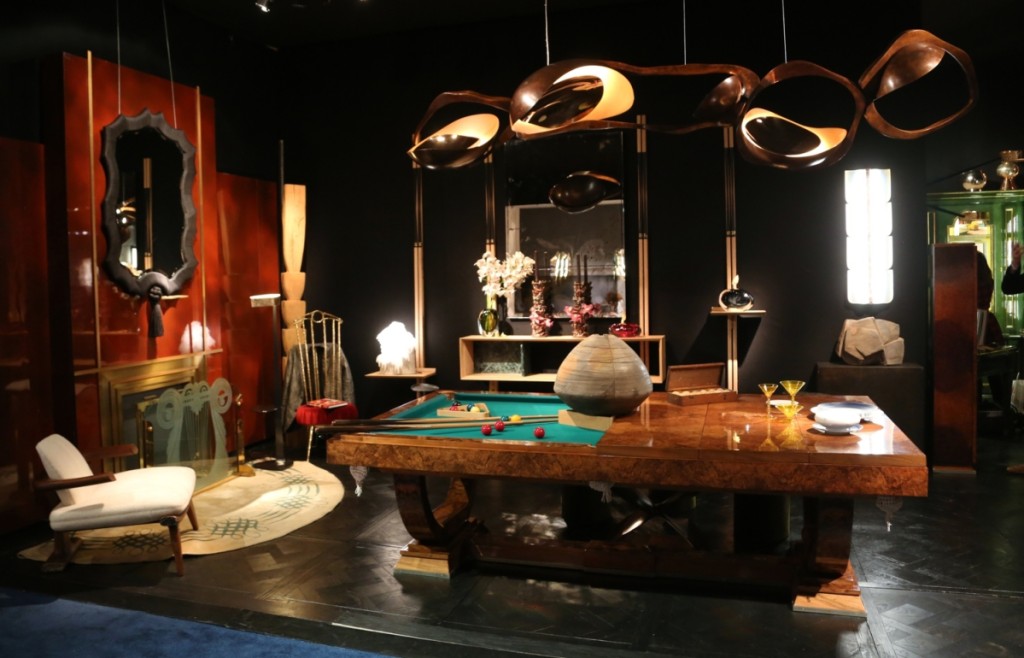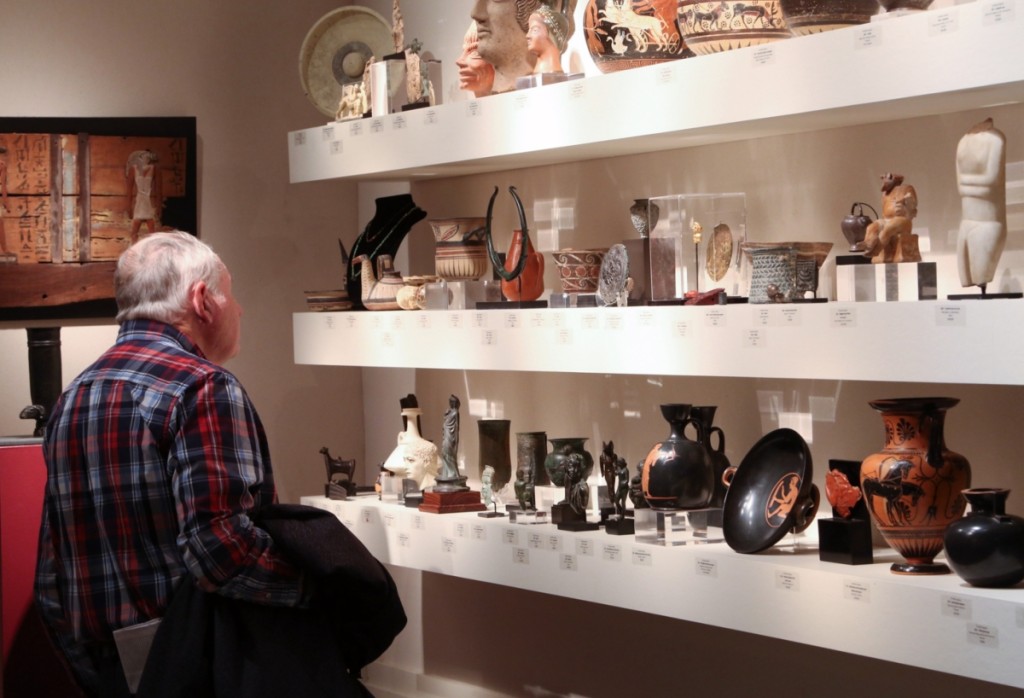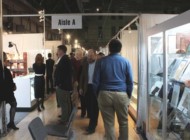Review and Photos by Greg Smith
NEW YORK CITY – Suffice to say, there’s a lot that went on in the Big Apple in November. But unique among the lures of commercial art – throwing around elbows between the $1-plus billion that changed hands at the top three houses when the Twentieth Century and Contemporary sales preceded the American art sales, and then on to the private gallery events and the American Art Fair – was the rather luxe Salon Art + Design, a show that trots the globe for you and brings it all, wrapped up nicely, to the Park Avenue Armory each year. This year’s November 14-18 edition saw 56 galleries come together from all over the world – exactly half of which were domestic, or with a domestic branch location – to present historical and contemporary design and art. This included rare examples from practitioners of furniture-as-art, bench-made and computer-driven design, works of art from Twentieth Century masters, historic design from iconic movements, antiquities, studio glass, ceramics and more.
The Salon’s executive director Jill Bokor saw attendance at the fairs eighth edition rise to 13,500, a small bump from last year.
As computer-driven design ramps up in the Twenty-First Century, the Salon’s show floor – a meeting place of new and old, refined and exuberant, representational and abstract – is apt to feature it and create a dialogue that spans history. And to steer that dialogue are the galleries, many of which will focus in either new or old, a scant few with both, but all of which possess the expertise and knowledge of the great design index through the ages. And that the Salon combines these galleries, in what has become the best design show in New York City, raises the earning of its own notecard and place in that index.
“We hit every decade of the Twentieth Century,” Bokor said, speaking to the broad range of material on the floor. “I tried to hit that for the past five years and I think we did that this year.”
On the spread between historic and contemporary offerings, Bokor said, “In terms of material brought and bought, we kept about as much vintage, and maybe even brought a little more vintage back this year. I wouldn’t mind having a little more historic material on the floor. But the contemporary work sold strongly. I think because there are antique shows, and Design Miami is contemporary, I think people want the mix, but they’ve seen less of the contemporary work and it’s exciting to them. In historic design, things like Italian vintage walks right out of here, but there’s a fascination with new material.”
As we filtered through our responses to the show this year, the word came back that floor sales were slow for a majority. Dealers had a hard time breaking even with the cost that comes associated with exhibiting at the Park Avenue Armory. That response has become a standard for almost every show in the Park Avenue Armory. It is, no doubt, known as a risky and high-value venue. Reasons offered included a crowded November calendar, an uncertain economy, the impeachment proceedings against Donald Trump and others. These sentiments apply to the market as a whole. It still did not change the fact that show manager Sanford L. Smith + Associates put on an astute show filled with some of the best design you’ll ever see in one place outside of a museum in New York.
When asked if she has any thoughts on leaving the Armory, Bokor responded in the negative.
“For many of these dealers, without the Armory, they don’t want to come. The real truth is that the real fulcrum of the show is the location. Even if I do hear some grumbling, we will surely be there for at least two more years.”
A lineup of interactive talks and special exhibitions made sure to round out this year’s offerings, and Bokor reflected on their success, saying, “It was one of the great new strengths of the show this year. The reception was almost as strong as the show on the floor. The quality of them was unbelievable, we’ve never had people like this doing our special exhibitions before.” In the exhibition by Lalique, British wall covering atelier Fromental created an installation influenced by the three F’s that define the Lalique brand: femme, flora and fauna. Design studios Apparatus, Pollaro and French designer Mathieu Lehanneur were all on hand to exhibit their latest work. And curated by Vogue Italia and artistic director and haute jewelry designer Alexandra Mor, “The Protagonist” exhibition showcased jewelry design by 15 studios.
Bokor also saw a good turnout on the booth talks at Wexler Gallery, Todd Merrill Studio and Heritage Gallery. “There were incredible talks,” she said, “this was a place where we saw improvement. Every single talk was oversubscribed, and that did not happen last year. The idea of programming at the Salon is something that has taken a while for visitors to understand, and they were well-received this year.” The Salon’s “Conversations” series featured six forums with architects, designers, journalists and other leaders, while six tours were offered and led by notable designers throughout the show run.
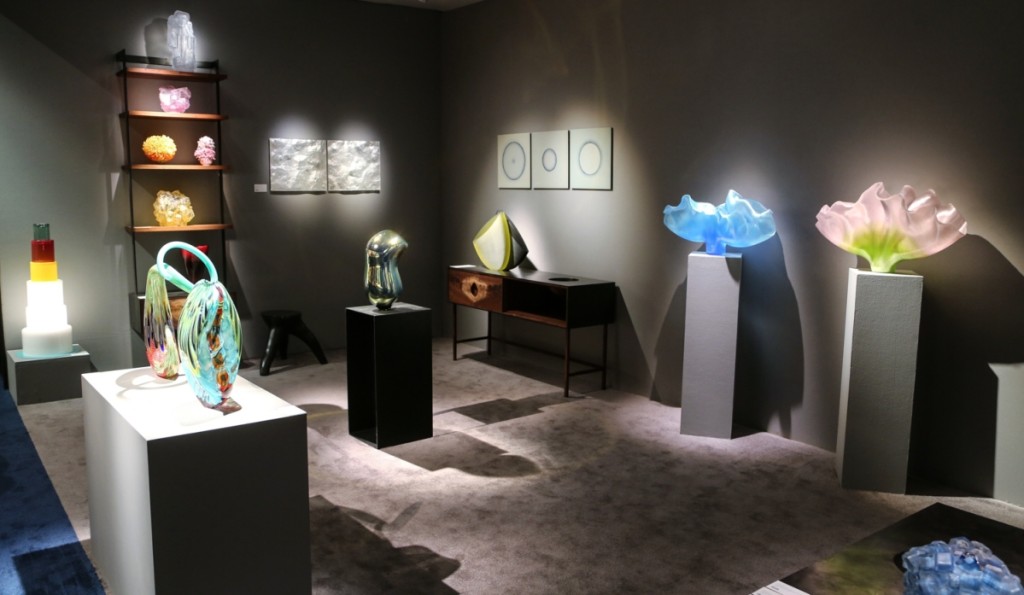
New York City’s Heller Gallery brought glass works from Steffen Dam, Toots Zynsky, Lino Tagliapietra, Eric Rosenfeld and more.
There was perhaps no greater link on the show floor between contemporary computer-driven design and historic bench-made furniture than the work of UK-designer Gareth Neal, who was exhibiting with London’s Sarah Myerscough Gallery. Neal’s exhibition surveyed the designer’s latest experiments with 3D computer drawing, new materials and CNC processes. On exhibit was a large vessel from his “SiO2” series, which is formed with machine cutting from a block of silica. “We’ve really gone to town studying traditional pottery,” Neal told Antiques and The Arts Weekly, explaining how he created these vessels to emulate the wall thickness and build of examples made today and throughout history in pottery studios. But Gareth’s techniques afford him a new aesthetic in a new medium, evident in the tidal contour patterns in this vessel and its texture and shape, which is not unlike the voluptuous figure of an ancient Venus figurine. Gareth is working on a series of essays that challenge the notions of craftsmanship in relation to the hand. He contrasts the idea of risk, associated with handwork, with the idea of precision, associated with machine work. But he makes note that when we travel into uncharted waters, like a CNC machine cutting through a block of silica, the results are not always perfect at first – refinement and risk still applies. The example on exhibit here, the first of its series, took three drafts to perfect before he was able to finish with only a toothbrush.
Speaking of antiquities, Phoenix Ancient Art brought with them an offering from the collection of Dr Walter Gilbert, a Nobel Prize-winning scientist and exhibiting artist. Together with his wife Celia, the couple amassed an important collection that spoke of the birth of Western art around the Mediterranean Basin to Asia and Mesoamerica, focusing specifically on Greece, Rome, Etruria, Egypt and Mesopotamia. Highlights here included a Roman micromosaic emblema in a stone tesserae from the First Century CE, depicting a long-haired lap dog sitting on a stool with a brush close by. Also here was a Phoenician engraved shell with the head of the Egyptian god Horus from the Seventh Century BCE. “It was probably a cult piece,” said the gallery’s curator Alexander Kruglov, “maybe for libations.” The shell featured images of rams on it, which were sacrificial animals. The decoration to both front and back signify the great care that was taken to make this piece, which likely had ceremonial use.
A selection of world-class early Twentieth Century American decorative arts was on exhibit with New York City’s Bernard Goldberg Fine Arts. On one wall hung three stencils from Prairie School architect George Grant Elmslie, who worked with Frank Lloyd Wright at the office of Joseph Lyman Silsbee and then Dankmar Adler and Louis Sullivan. Elmslie was Sullivan’s chief draftsman and ornamental designer. In 1909, Elmslie joined William Gray Purcell and George Feick Jr to create an architectural practice of their own. Feick left three years later, and the firm of Purcell and Elmslie would go on to be the second most commissioned architectural firm of the Prairie School behind Frank Lloyd Wright. The stencils on hand with Bernard Goldberg dated to the Purcell and Elmslie era, circa 1915. “They’re a hallmark of his style,” research associate Lisa Rotmil told us. “The abstracted leaves and buds and a stretched-out pelt – he used all of these motifs with a natural base and would modernize them.” The gallery also featured the evolving and contrasting styles of Edgar Brandt, found in a circa 1925 wrought iron mantel clock in the artist’s delicate and highly detailed naturalist style, which contrasted with the Machine Age aesthetic of a pair of chrome-plated lamps with Daum shades that Brandt produced in 1931.
We can still recall the 2018 booth of Dutch gallery Priveekollektie Contemporary Art | Design, and we have no doubt that the 2019 booth will stick with us as well. At the front of it was “Armor II,” a full-size suit of arms in white porcelain and natural leather by Hans van Houwelingen. Two tables, “Golden Lagoon,” with a glass base, and “Secret Lagoon,” with a bronze base, were part of Reinier Bosch’s “The Melting Series” of furniture, which features robust drops of glimmering gold bronze dripping from the edges of the tabletop. The gallery wrote that Bosch’s series is connected to the capture of a single moment in time, as if to suspend it for eternal viewing.
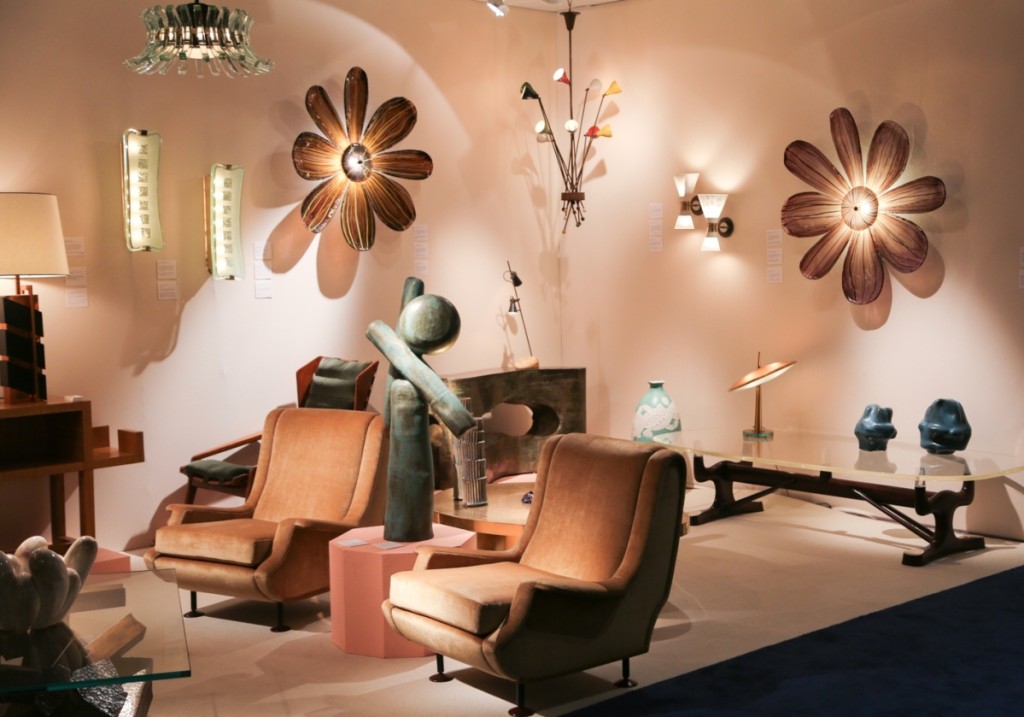
Paul Donzella said he wished he had more of the illuminated flower glass wall sculptures on the back wall. The 1972 works were custom commissions from Murano glass studio Cenedese and were originally mounted to the ceiling of the bar at the Lido Hotel on Lido Island off Venice, Italy. Both sold. Donzella, New York City.
By the time we rolled through New York City gallery Donzella’s booth on the first full day of the show, a red dot graced one of the two circa 1972 “Margherita” illuminated wall sculptures by Murano glass studio Cenedese, depicting a 45-inch diameter daisy flower. He sold the second shortly after, and a third that is still in Italy. The sculptures were originally mounted to the ceiling of the bar at the Lido Hotel on Lido Island off Venice, Italy. Vintage Italian design was found throughout the booth, including a pair of “Regent” lounge chairs, circa 1960, by Marco Zanuso and lighting designs by Angelo Lelli for Arredoluce.
“For me, there was a very strong designer presence during the fair,” owner Paul Donzella said. “Certainly collectors, too. I feel like the Salon has matured into the best NYC fair for Twentieth and Twenty-First Century material. The energy is always fantastic and I think Jill Bokor has done a stellar job in curating such a strong collection of gallerists to partner with.”
Italian design was also found with Jim Elkind at New York City’s Lost City Arts, which recently moved to the New York Design Center at Lexington Avenue between 32nd & 33rd Street. The gallery featured a rare “adjustable” furniture suite by Italian architect-designer Gio Ponti, consisting of two lounges and a table. “I just made a trip to Italy this past summer and we brought these back,” Elkind said, as well as other pieces in the booth. “The adjustable pieces were made for domestic consumption and they’re quite special.” The Ponti chairs would recline back to various degrees and even flatten out to a bench form.
Moderne Gallery, Philadelphia, treated visitors with a selection of blackened maple seating by furniture artist John Eric Byers in his signature uniform dimpled, chip-carved surface. The furniture framed in an original 1956 collage by John Cage that was designed for textile designer Jack Lenor Larsen’s holiday card that year. Larsen liked it so much he commissioned Cage to do the 1957 card, and Cage would go on to become Larsen’s artistic director for the next 40 years. Gallery owner Robert Aibel related a few sales of ceramics from American artist Estelle Halper, but said his other offerings – from American craftsmen and women George Nakashima, David Ebner and Miriam Carpenter – fell flat. “The show got more publicity than ever before, word of mouth was strong,” Aibel said. “Everyone I met seemed to know about the show… Attendance seemed strong, and I thought that the show never looked better. It also had a very eclectic mix of great pieces. I really don’t know of a better-looking show with quality pieces of great design in many different styles.” He added, “though personally I’d always like to see more vintage material.”
Moscow-based Heritage International Art Gallery brought a range of historic design furniture from that country that elicited much interest, as so little Soviet-era and Russian design makes its way stateside. Among them was a carved oak folding screen and tribune designed by Alexander Dmitriev circa 1934 that was made for the children’s military labor commune Lenoblono. Both featured state symbols, including the hammer and sickle, as well as compass stars and leader profiles. The five-part screen was made to wrap around the tribune when it was not in use. This gallery held a booth talk during the show and it was very well-attended.
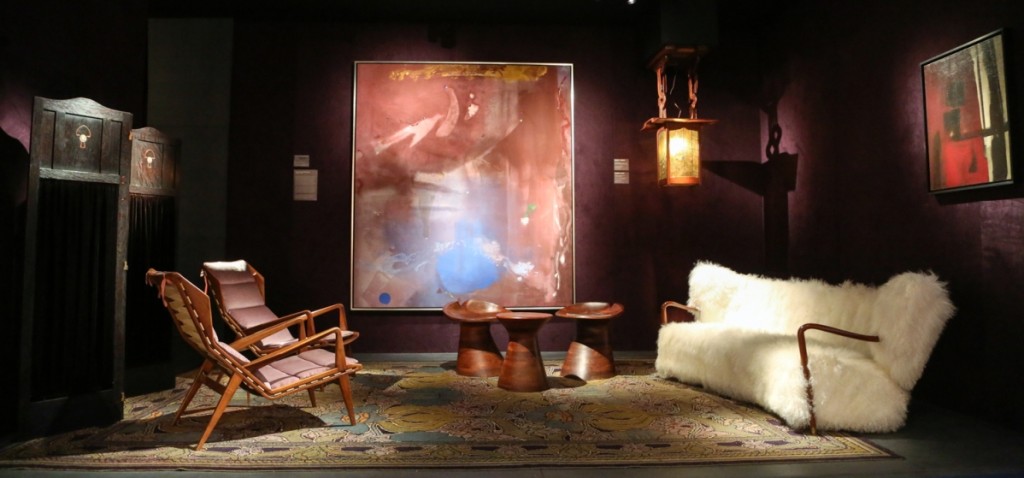
Designs from Harvey Ellis, Gio Ponti, C.F.A. Voysey, Wendell Castle and Greene & Greene were on show with Geoffrey Diner Gallery, Washington, DC.
Historic design was also on show with Geoffrey Diner Gallery, Washington, DC. Flanking a monumental 1985 oil on canvas painting by Helen Frankenthaler titled “Cinquecento” were a set of three 1967 Mushroom Stools by Wendell Castle and an entry hall lantern from Arts and Crafts architect-designer Greene & Greene. The 1907 lantern of inlaid mahogany and a greenish-yellow stained glass with natural motifs originated from the Blacker House in Pasadena, Calif. Other Arts and Crafts offerings included a three-panel oak screen with pewter and copper inlay by Harvey Ellis for Gustav Stickley, circa 1904, and a Donegal carpet by UK designer/architect C.F.A. Voysey. Voysey’s carpets were very popular during his era, so much so that Stickley sold them in his stores.
Looking forward to next year, Bokor did not see any glaring points that need to change and she expects about 80 percent of dealers to return. Though she did speak with general uncertainty about what lies ahead for what is sure to be an extremely tumultuous 2020.
“Despite the strength of the stock market, there’s an incredible unease in every way here. And it absolutely trickles down to sales. I think everyone is right to be concerned – everyone that’s running a show.”
We have little doubt that this event will weather that storm, whichever way it blows.
The next edition will be November 19-23, 2020. For information, 212-777-5218 or www.thesalonny.com.

